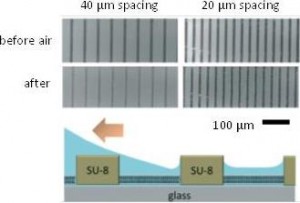Researchers at National Taiwan University design grating structures to prevent air-water interfaces from destroying lipid bilayers, enabling robust bioassays of synthetic membranes.
Supported lipid bilayers (SLBs) are useful as platforms to simulate cell membranes for evaluating transport of toxins and viral particles1 and screening new pharmaceutical reagents. Yet a significant challenge is maintaining the integrity of SLBs throughout an experiment. Air-water interfaces, commonly formed during reagent changes and rinses, peel apart SLBs and delaminate them from the substrate. Strategies to preserve SLB integrity involve coating SLBs with polymers to increase their rigidity or adding proteins and sugars to form protective layers with a high bending modulus above the membrane. These methods modify the chemical structure and environment of SLBs, preventing analysis of membrane properties and specific assays of membrane-tethered species. Thus, Chung-Ta Han and Ling Chao developed a substrate with patterned gratings to prevent air-water interfaces from directly contacting SLBs when an air bubble is introduced into a microchannel with SLBs.
The grating structures, fabricated by standard photolithography, are perpendicular to fluid flow in the microchannel and act as obstacles to air-water interfaces contacting SLBs directly by a ‘tenting’ mechanism (see figure at right). Holding the obstacle height constant at 2 μm, Han and Chao evaluated obstacle spacing at different flow rates influenced SLB stability after treatment with an air bubble. 40 μm spacing was found to efficiently preserve SLBs from air-water interfaces at a practical range of flow rates: 60 – 6000 mm/min. The authors also confirmed the integrity of the membranes by comparable diffusivity measurements within the SLBs before and after air-bubble treatment. Finally, the authors demonstrated that air bubbles did not affect receptor-ligand interactions between species embedded in the SLBs and surrounding buffer when SLBs were protected using the microfabricated obstacles.
This platform uses integrated barriers to protect SLBs from air-water interfaces, creating SLBs with native properties to study biomolecule behavior within membranes and perform high throughput analytical assays utilizing synthetic membranes.
Download the full article now – free* access for a limited time only!
Using a patterned grating structure to create lipid bilayer platforms insensitive to air bubbles
Chung-Ta Han and Ling Chao. Lab Chip, 2015, 15, 86 – 93.
DOI: 10.1039/c4lc00928b
[1] I. Kusters, A. M. Van Oijen and A. J. Driessen, ACS Nano, 2014, 8, 3380-3392.
*Access is free until 06.02.15 through a registered RSC Publishing account.










